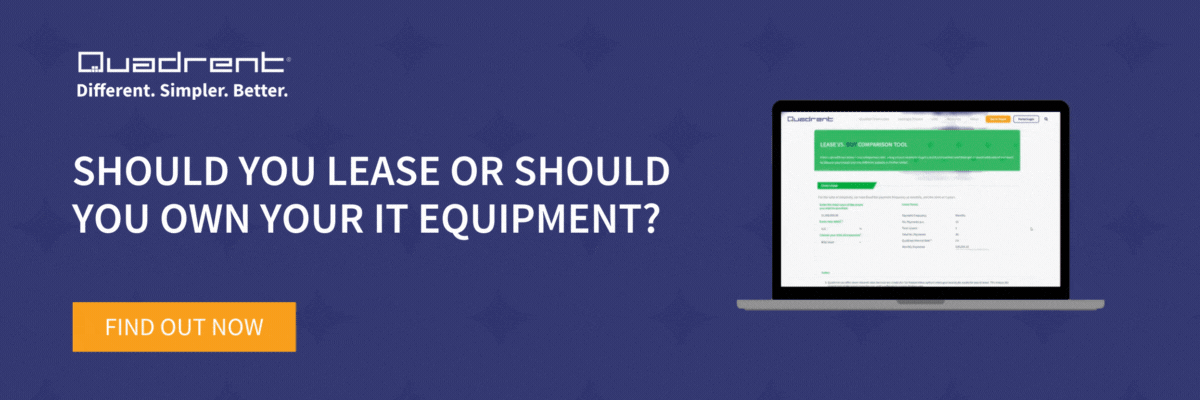Business technology leasing offers benefits — flexibility, cost-efficiency, and smooth upgrades — that can help drive success
Lease vs buy - a decision organisations have struggled with for decades. It can be a particularly tough choice especially when a business is still in the planning phase of their tech procurement process but getting it right from the start can have significant long-term benefits.
Thinking about how the right equipment can drive your business forward is important. Whether it’s upgrading IT systems, investing in telecommunications, or improving office hardware, these decisions are critical to your long-term success.
One of the key considerations during this planning phase is how you’ll manage your technology lifecycle — whether through purchasing or leasing. While it’s easy to focus on the equipment itself, understanding how different acquisition models, like leasing, can impact your business is essential.
Let's explore five signs that might suggest leasing your technology is a smart option, helping you make informed choices as you move forward in the planning process.
Sign 1: Scaling operations or expanding into new markets
When your business is growing or entering a new market, access to the right technology is imperative. However, the high upfront costs of purchasing equipment can be a barrier, especially when resources need to be allocated across various aspects of expansion. Leasing technology offers a flexible solution by allowing businesses to acquire essential IT equipment without the immediate financial burden of ownership.
By leasing, you can deploy cutting-edge technology quickly, smoothing your entry into the market and providing scalability without the risk of capital constraints. This approach provides the financial breathing room to invest in other critical areas, like marketing or staffing, while still making sure your operations are supported by the best tools available. Additionally, leasing allows for easier upgrades as your business evolves, keeping you ahead of the curve in competitive markets.
Sign 2: Major business initiatives - mergers or acquisitions
Large-scale projects, such as mergers or acquisitions, often demand significant technology consolidation and infrastructure upgrades. These initiatives can involve integrating disparate systems, standardising IT equipment, and boosting capabilities to support a larger, unified organisation. The financial outlay for purchasing new technology during such transitions can be pretty daunting.
Leasing provides a cost-effective alternative, allowing companies to access the latest technology without the immediate capital investment required for ownership. Leasing not only simplifies the integration process but also means businesses can upgrade or replace technology as needed, making sure that all teams are equipped with standardised, innovative solutions. With leasing, you can maintain financial flexibility while ensuring your business remains agile and scalable throughout these complex initiatives.
Sign 3: Upgrading legacy systems - driving digital transformation
As your business evolves, legacy systems can become a roadblock to growth, efficiency, and digital transformation. Outdated technology often lacks the capabilities needed to support modern business processes, but the costs of replacing these systems can be prohibitively high. This is where leasing technology offers a strategic advantage.
Rather than committing to a significant capital expenditure (CAPEX) upfront, leasing means you can modernise your IT infrastructure without the burden of long-term ownership. With lease agreements, you can access the latest technology required for digital transformation initiatives, keeping operations agile and competitive. Leasing also offers the flexibility to upgrade regularly, making sure that your business remains on the cutting edge of technological advancements without the financial strain of continuous purchases.
Sign 4: Implementing sustainability and ESG goals
If your organisation is committed to achieving sustainability and Environmental, Social, and Governance (ESG) goals, technology leasing can play a crucial role in reducing your environmental impact. Leasing supports sustainable procurement practices by making sure that equipment is either reused or responsibly recycled at the end of its life within the organisation.
By leasing IT equipment, you can minimise e-waste, as many leasing providers offer environmentally friendly disposal or refurbishment programs. Leasing also means that businesses are using energy-efficient, up-to-date technology, that can contribute to a lower carbon footprint. If your company is aiming to implement sustainable practices without the long-term commitment of ownership, leasing is a smart, cost-effective solution that promotes both environmental responsibility and operational efficiency.
Sign 5: Budget constraints or uncertain financial climate
During periods of economic uncertainty or when operating under tight budget constraints, businesses need to maintain access to essential technology without compromising their financial stability. Technology leasing provides a predictable, manageable solution by allowing your organisation to spread costs over time rather than investing large amounts of capital upfront.
With leasing, you can budget more effectively and adapt to fluctuating economic conditions while making sure you still have the latest IT equipment needed to stay competitive. This financial flexibility is especially valuable during periods of economic downturn or when the market is behaving unpredictably. Leasing not only helps maintain liquidity but means you can scale your technology needs in alignment with your financial health, making it an ideal option for managing both operational and financial risks.
Why business technology leasing is the smart choice
Now more than ever, technology leasing offers a strategic way to stay competitive while maintaining financial flexibility, especially if your business is right at the beginning of your tech buying/planning process. From scaling up for business expansion to managing large projects, upgrading legacy systems, supporting sustainability goals, or navigating budget constraints, leasing gives you access to cutting-edge technology without the high upfront costs of buying.
Leasing also means that your business can remain agile, modernise as needed, and avoid being tied to outdated equipment. It also simplifies financial planning by turning technology costs into predictable, manageable payments. By choosing to lease technology, you gain the flexibility, cost-efficiency, and sustainability advantages necessary to thrive in an ever-evolving market.
Try our Lease vs. Buy comparison tool. Using a simple example, you can compare leasing and buying on a level playing field to get a quick overview.
